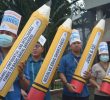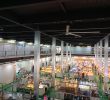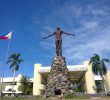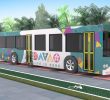On the other hand, foreign and local capitalists dominate local industry and services. Transnational corporations (TNCs) are concentrated to a large extent in manufacturing, followed by wholesale and retail trade and financial intermediation. In manufacturing, TNCs account for the bulk of the revenues derived by the top 1,000 corporations.
The largest TNCs operating in the country include the likes of Texas Instruments, Royal Dutch Shell, Toshiba, Chevron-Texaco, Nestl�, Fujitsu, Philips, Zuellig and Panasonic. By nationality, over half of the TNC revenues are accounted for by Japan (29.4%) and the US (23.8%), distantly followed by the Netherlands (7.3%), Great Britain (6.8%), Switzerland (3.5%) and Germany (1.6%).
The largest transnational banks (TNBs) operating in the country are Citibank, Hong Kong and Shanghai Banking Corporation (HSBC), Standard Chartered and Deutsche Bank, and ING Bank, with the top five TNBs net income reaching P5.5 billion in 2004.
Local family conglomerates are owned and controlled by the country�s biggest landlords and businessmen. The top ten conglomerates in 2004 were those owned by the Cojuangcos (San Miguel Corporation); Gokongweis (JG Summit); Ayalas (Ayala Corporation); Henry Sy (SM Investments); Lopezes (Benpres Holdings); George Go and family (Equitable PCI, which has lately merged with Banco de Oro owned by the Sy family); Concepcions (RFM Corporation); Villars (Filinvest); Pangilinans (Metro Pacific); and Andres Soriano and family (A. Soriano Corporation). Their revenues in 2004 totaled P334 billion.
No Trickle-Down
There has been increasing poverty and inequality under Arroyo despite much-hyped economic growth. This only serves to underscore the distorted character of the economy during her watch.
Late last year, the government as well as private economists claimed that per capita income or the share of every Filipino in the country�s wealth as measured by the gross domestic product (GDP) would hit $1,400 (approximately P71,834) by the end of 2006. But even government economic planners had to admit that the national wealth was not shared equally.
In fact, if the shares to total income defined in the 2003 FIES were used to allocate the 2006 GDP, the poorest 10% would have a per capita annual income of just P2,781 while the richest 10% would have a per capita income of P56,695 (based on an average family size of five).
This inequality is further reflected in the huge gap between the wealth of the country�s richest individuals and families and the poorest Filipinos. The US$12.4 billion net worth as of 2006 of the country�s 10 richest is equivalent to the combined annual income of the poorest 9.8 million households (i.e. P625 billion in 2003).
Hence, more than ever, economic growth under Arroyo continues to measure the growing profits and wealth of a few rather than the welfare of the many. But in the context of a Philippine economic system that favors the rich and powerful, it should not be surprising that while poverty increases in the country, so does inequality. IBON Features/davaotoday.com










